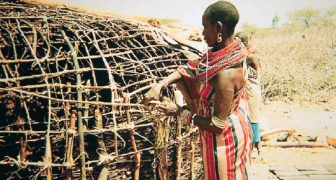The Samburu are, traditionally, a pastoral society found in central northern Kenya. They probably number between 100,000 and 200,000. The Samburu are closely related to the Maasai, they speak a dialect of Maa, and they share a common history with the Maasai and have a similar social organization. Both are polygamous and have age-sets; Spencer identified six ascending levels of a segmentary descent system: the lineage group, hair-sharing group, sub-clan, clan, phratry, and moiety.
There are, however, important differences from the Maasai. The Samburu have been less affected by colonial land alienations. Indeed, the Leroghi Plateau, which they now occupy, was once cleared of Maasai for colonial occupation but incorporated into the White Highlands. The Samburu have also, relatively recently, adopted camel pastoralism. Camels are expensive stock requiring very different treatment and herding from cattle. Their adoption has been eased by the harsher and drier conditions in the lands where the Samburu live.
 The Samburu are close allies with the Rendille and Ariaal, both smaller pastoral groups who live in the same region. In common with other ethnic groups in the region, they intermarry and form diverse alliances of trade, friendship, and cooperation. In times of extreme hardship, such as the rinderpest epidemic of the late 1880s, the surviving Samburu sought refuge among their neighbors.
The Samburu are close allies with the Rendille and Ariaal, both smaller pastoral groups who live in the same region. In common with other ethnic groups in the region, they intermarry and form diverse alliances of trade, friendship, and cooperation. In times of extreme hardship, such as the rinderpest epidemic of the late 1880s, the surviving Samburu sought refuge among their neighbors.
In common with other pastoralists in this region, Samburu homes consist of an inner kraal around which huts are built by adult married women, and the whole is fenced with bushes. Several families can share one compound, although stock may be segregated and each man’s herd may leave by a different gate. Stock are valuable for all sorts of purposes; the favored food, however, is milk, which women collect in the morning and evening from cattle allocated to them on marriage. It is not typical for wives to share each other’s stock. Indeed, it is quite possible for one wife’s herd to prosper and another to fail. Each has to contend with her fate. Although wives milk and tend animals and allot them to their children, sale of stock is a male prerogative, leading to problems of impoverishment for families with profligate or alcoholic fathers and intense family debates over which animal is sold.
In recent years, the Samburu have experienced the diverse problems with their governments that afflict most pastoral populations. These include the pressures to settle and adopt sedentary livelihoods amid allegations of desertification, the requirement to modernize, and, allegedly, state-sponsored cattle raiding. Recently they have also lost land to conservation interests with the establishment and enforcement of protected areas. They, like the Maasai, have generally resisted pressure to change their dress, but livelihoods are diverse. In common with other groups, Samburu politics are responding to the new opportunities presented by nongovernmental organizations.
References:
- Holtzman, J. (2001). The food of elders, the “ration” of women: Brewing, gender, and domestic processes among the Samburu of northern Kenya. American Anthropologist, 103(4), 1041-1058.
- Spencer, P. (1965). The Samburu. A study of gerontocracy in a nomadic tribe. Berkeley: University of California Press.
- Spencer, P. (1973). Nomads in alliance: Symbiosis and growth among the Rendille and Samburu of Kenya. London: Oxford University Press.

